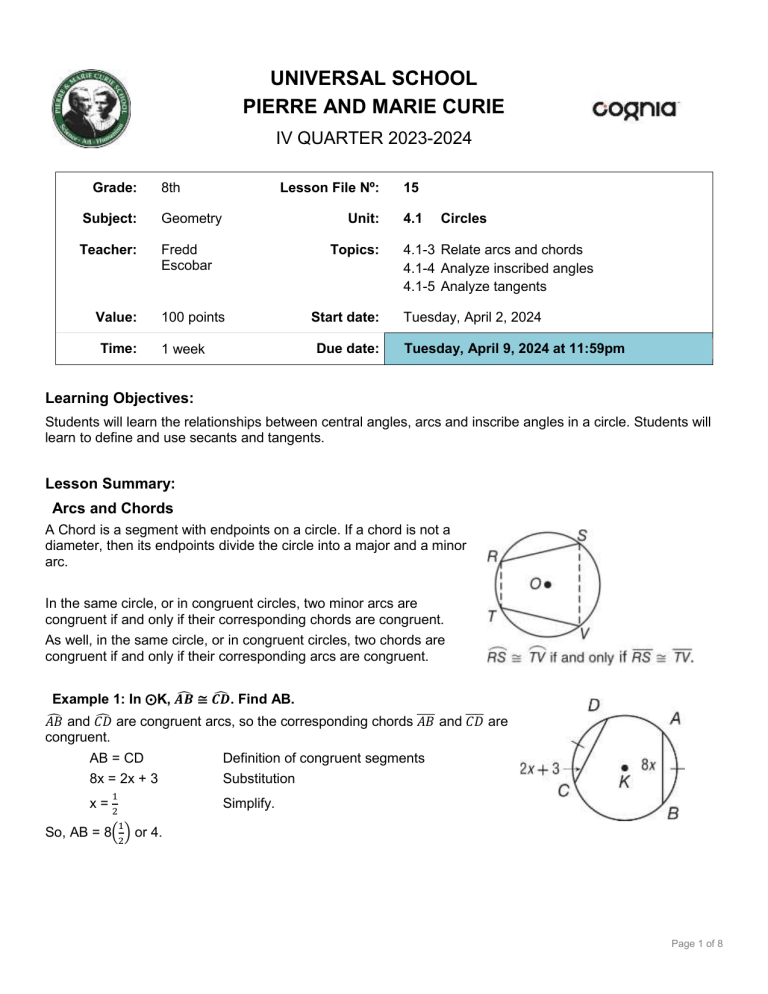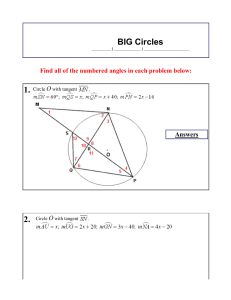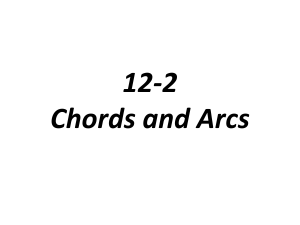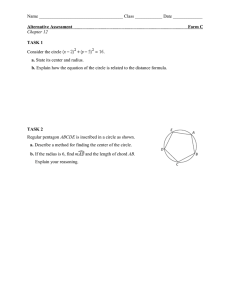
UNIVERSAL SCHOOL PIERRE AND MARIE CURIE IV QUARTER 2023-2024 Grade: 8th Lesson File Nº: 15 4.1 Subject: Geometry Unit: Circles Teacher: Fredd Escobar Topics: Value: 100 points Start date: Tuesday, April 2, 2024 Time: 1 week Due date: Tuesday, April 9, 2024 at 11:59pm 4.1-3 Relate arcs and chords 4.1-4 Analyze inscribed angles 4.1-5 Analyze tangents Learning Objectives: Students will learn the relationships between central angles, arcs and inscribe angles in a circle. Students will learn to define and use secants and tangents. Lesson Summary: Arcs and Chords A Chord is a segment with endpoints on a circle. If a chord is not a diameter, then its endpoints divide the circle into a major and a minor arc. In the same circle, or in congruent circles, two minor arcs are congruent if and only if their corresponding chords are congruent. As well, in the same circle, or in congruent circles, two chords are congruent if and only if their corresponding arcs are congruent. Example 1: In ⨀K, 𝑨𝑩 ≅ 𝑪𝑫. Find AB. 𝐴𝐵 and 𝐶𝐷 are congruent arcs, so the corresponding chords 𝐴𝐵 and 𝐶𝐷 are congruent. AB = CD Definition of congruent segments 8x = 2x + 3 Substitution 1 x=2 Simplify. 1 So, AB = 8 2 or 4. Page 1 of 8 Bisecting Arcs and Chords • In a circle, if a diameter (or radius) is perpendicular to a chord, then it bisects the chord and its arc. • In a circle, the perpendicular bisector of a chord is the diameter (or radius). • In a circle or in congruent circles, two chords are congruent if and only if they are equidistant from the center. If 𝑊𝑍 ⊥ 𝐴𝐵 , then 𝐴𝑋 ≅ 𝑋𝐵 and 𝐴𝑊 ≅ 𝑊𝐵 . If OX = OY, then 𝐴𝐵 ≅ 𝑅𝑆. If 𝐴𝐵 ≅ 𝑅𝑆, then 𝐴𝐵 and 𝑅𝑆 are equidistant from point O. Example 2: In ⨀O, 𝑪𝑫 ⊥ 𝑶𝑬, OD = 15, and CD = 24. Find OE. A diameter or radius perpendicular to a chord bisects the chord, so ED is half of CD. 1 ED = 2 (24) = 12 Use the Pythagorean Theorem to find OE in △OED. (𝑂𝐸)2 + (𝐸𝐷)2 = (𝑂𝐷)2 2 2 (𝑂𝐸) + 12 = 15 2 (𝑂𝐸)2 + 144 = 225 2 (𝑂𝐸) = 81 OE = 9 Pythagorean Theorem Substitution Simplify. Subtract 144 from each side. Take the positive square root of each side. Inscribed Angles An inscribed angle is an angle whose vertex is on a circle and whose sides contain chords of the circle. In ⨀G, minor arc 𝐷𝐹 is the intercepted arc for inscribed angle ∠DEF. Inscribed Angle Theorem If an angle is inscribed in a circle, then the measure of the angle equals one-half the measure of its intercepted arc. There are three ways that an angle can be inscribed on a circle. Page 2 of 8 If two inscribed angles intercept the same arc or congruent arcs, then the angles are congruent. Example 3: In ⨀G above, m 𝑫𝑭 = 90. Find m∠DEF. ∠DEF is an inscribed angle, so its measure is half of the intercepted arc. 1 m∠DEF = 2m𝐷𝐹 1 = 2(90) or 45 Angles of Inscribed Polygons An inscribed polygon is one whose sides are chords of a circle and whose vertices are points on the circle. Inscribed polygons have several properties. • An inscribed angle of a triangle intercepts a diameter or semicircle if and only if the angle is a right angle. • If a quadrilateral is inscribed in a circle, then its opposite angles are supplementary. If 𝐵𝐶𝐷 is a semicircle, then m∠BCD = 90. For inscribed quadrilateral ABCD, m∠A + m∠C = 180 and m∠ABC + m∠ADC = 180. Example 4: Find m∠K. 𝐾𝐿 ≅ 𝐾𝑀, so KL = KM. The triangle is an isosceles triangle, therefore m∠L = m∠M = 3x + 5. m∠L + m∠M + m∠K = 180 (3x + 5) + (3x + 5) + (5x + 5) = 180 11x + 15 = 180 11x = 165 x = 15 Angle Sum Theorem Substitution Simplify. Subtract 15 from each side. Divide each side by 11. So, m∠K = 5(15) + 5 = 80. Page 3 of 8 Tangents A tangent is a line in the same plane as a circle that intersects the circle in exactly one point, called the point of tangency. There are important relationships involving tangents. A common tangent is a line, ray, or segment that is tangent to two circles in the same plane. • A line is tangent to a circle if and only if it is perpendicular to a radius at a point of tangency. • If two segments from the same exterior point are tangent to a circle, then they are congruent. If 𝑅𝑆 ⊥ 𝑅𝑃 , then 𝑆𝑅 is tangent to ⨀P. If 𝑆𝑅 is tangent to ⨀P, then 𝑅𝑆 ⊥ 𝑅𝑃 . If 𝑆𝑅 and 𝑆𝑇 are tangent to ⨀P, then 𝑆𝑅 ≅ 𝑆𝑇 . Page 4 of 8 Example 5: 𝑨𝑩 is tangent to ⨀C. Find x. AB is tangent to ⨀C, so 𝐴𝐵 is perpendicular to radius 𝐵𝐶 . 𝐶𝐷 is a radius, so CD = 8 and AC = 9 + 8 or 17. Use the Pythagorean Theorem with right △ABC. (𝐴𝐵)2 + (𝐵𝐶)2 = (𝐴𝐶)2 𝑥 2 + 82 = 172 2 𝑥 + 64 = 289 Pythagorean Theorem Substitution Simplify. 2 𝑥 = 225 Subtract 64 from each side. x = 15 Take the positive square root of each side. Circumscribed Polygons When a polygon is circumscribed about a circle, all of the sides of the polygon are tangent to the circle. Hexagon ABCDEF is circumscribed about ⨀P. Square GHJK is circumscribed about ⨀Q. 𝐴𝐵, 𝐵𝐶 , 𝐶𝐷, 𝐷𝐸, 𝐸𝐹 , and 𝐹𝐴 are tangent to ⨀P. 𝐺𝐻, 𝐽𝐻, 𝐽𝐾 , and 𝐾𝐺 are tangent to ⨀Q. Example 6: △ABC is circumscribed about ⨀O. Find the perimeter of △ABC. △ABC is circumscribed about ⨀O, so points D, E, and F are points of tangency. Therefore AD = AF, BE = BD, and CF = CE. P = AD + AF + BE + BD + CF + CE = 12 + 12 + 6 + 6 + 8 + 8 = 52 The perimeter is 52 units. Activities: Find the value of x in each circle. (Example 1) 1. 2. 3. Page 5 of 8 4. 5. 6. 8. ⨀M ≅ ⨀P 9. ⨀V ≅ ⨀W (Example 2) In ⨀P, the radius is 13 and RS = 24. Find each measure. Round to the nearest hundredth. 10. RT 11. PT In ⨀A, the diameter is 12, CD = 8, and m𝑪𝑫 = 90. Find each measure. Round to the nearest hundredth. 13. m𝐷𝐸 14. FD 12. TQ 15. AF 17. In ⨀Q, 𝐶𝐷 ≅ 𝐶𝐵, GQ = x + 5 and EQ = 3x – 6. 16. In ⨀R, TS = 21 and UV = 3x. What is x? What is x? Find each measure. (Example 3) 18. m𝐴𝐶 21. m∠U 19. m∠N 22. m∠T 20. m𝑄𝑆𝑅 23. m∠A 24. m∠C Page 6 of 8 Find each measure. (Example 4) 25. x 26. x 27. m∠W 28. m∠T 29. m∠R 30. m∠W 31. m∠S 32. m∠X Find x. Assume that segments that appear to be tangent are tangent. (Example 5) 33. 34. 35. 36. 37. 38. For each figure, find x. Then find the perimeter. (Example 6) Page 7 of 8 39. 40. 41. 42. 43. 44 Assessment/Homework: Classwork: Solve all EVEN-numbered exercises from Activities Section. Homework: Solve all ODD-numbered exercises from Activities Section. Learning Outcome: Students find measures of inscribed angles. Students use properties of tangents. Page 8 of 8





